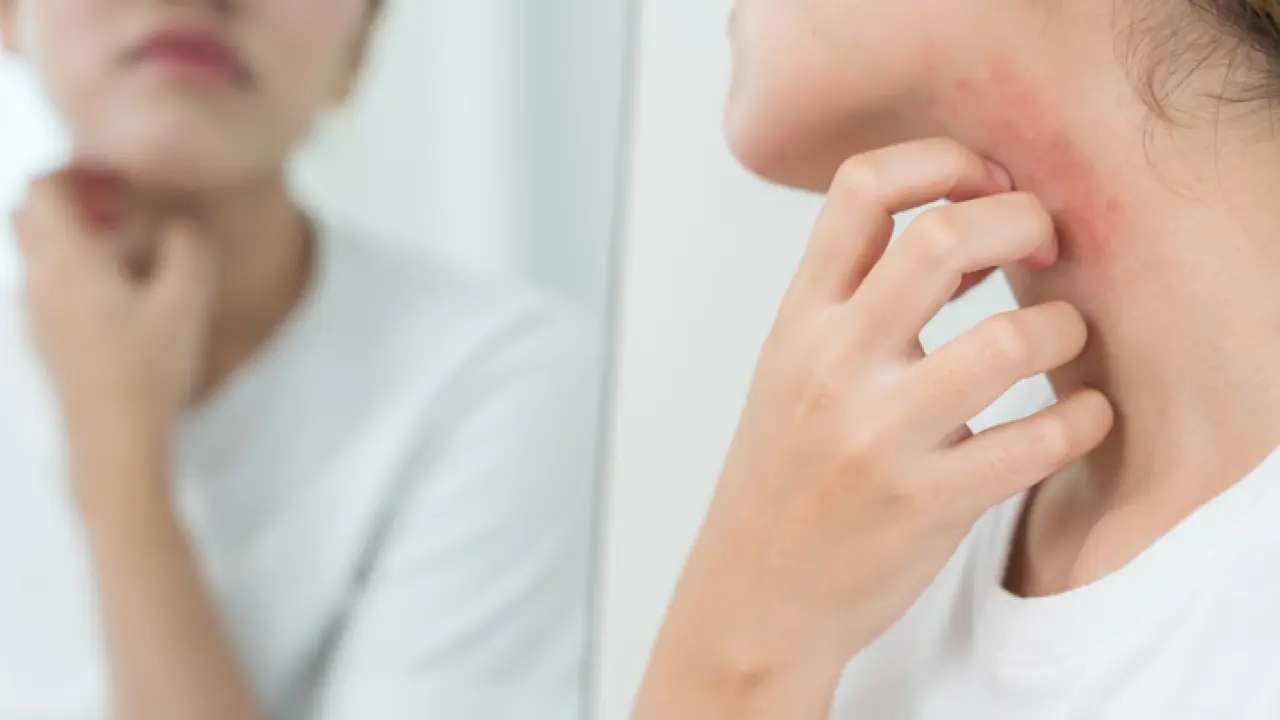Introduction
Here’s something nobody tells you about that mysterious circular rash: it’s probably not what you think it is.
Despite the creepy name “ringworm,” there are no actual worms involved. What you’re dealing with is a tinea infection — a fungal skin condition that’s way more common than most people realize. That itchy patch spreading on your arm? The persistent burning between your toes after the gym? The uncomfortable rash that showed up seemingly out of nowhere? All likely candidates for tinea, the umbrella term for a whole family of stubborn fungal infections.
Here’s the tricky part: these infections don’t just go away on their own. But here’s the good news — they’re highly treatable when you know what you’re dealing with and use the right approach. In this guide, we’re breaking down everything you need to know about tinea infections: how to spot them, what actually works to clear them up, and (just as importantly) how to keep them from coming back.
What is Tinea, Really?

Let’s clear up the confusion right away. Tinea is the medical name for fungal skin infections caused by dermatophytes — tiny fungi that have a particular appetite for keratin, the protein that makes up your skin, hair, and nails.¹ Dermatophytes are the most common cause of fungal skin infections worldwide.
Think of dermatophytes as unwelcome houseguests that prefer warm, damp environments. Your sweaty gym socks? Paradise. That steamy locker room floor? Five-star accommodations. The fold of skin where your thigh meets your groin after a long run? You get the idea.
What most people don’t realize is how easily these fungi spread. Tinea infections can be transmitted through direct skin-to-skin contact, contact with contaminated surfaces, or even from infected animals.¹ The fungi are hardy little survivors, capable of living on towels, bedding, and clothing for weeks at a time.
Types of Tinea Infections
Not all tinea infections look or feel the same. Here’s how to tell them apart:²
Tinea Type | Common Name | Where It Appears | Key Signs |
|---|---|---|---|
Tinea corporis | Ringworm | Body, arms, legs | Round rash with a raised edge and clearer center |
Tinea pedis | Athlete’s Foot | Feet, between toes | Itching, burning, peeling skin that won’t quit |
Tinea cruris | Jock Itch | Groin, inner thighs | Red, ring-shaped rash that’s maddeningly itchy |
Tinea capitis | Scalp Ringworm | Scalp | Scaly patches, sometimes with hair loss |
Tinea unguium | Nail Fungus | Fingernails, toenails | Thickened, yellowed, brittle nails |
Tinea versicolor | Pityriasis Versicolor | Torso, shoulders | Light or dark discolored patches |
Each type has its own personality, so to speak — but they all respond to the same basic game plan: consistent antifungal treatment paired with smart hygiene habits.
Symptoms and Early Signs

The symptoms depend on where the infection sets up shop, but there are some common threads:³
- Persistent itching or burning — not the kind that comes and goes, but the kind that demands your attention
- Red, scaly patches that tend to expand outward over time
- Circular or ring-like lesions (especially with ringworm on the body)
- Cracking or peeling skin between the toes or on the feet
- Discoloration — lighter or darker patches, particularly with tinea versicolor
If you’re seeing any combination of these signs, especially if they’re not improving with regular moisturizer or general skin care, it’s time to consider a fungal infection.
What Causes Tinea?
The culprits behind tinea infections are dermatophyte fungi — specifically species like Trichophyton, Microsporum, and Epidermophyton. These microscopic troublemakers are remarkably resilient, surviving on surfaces and fabrics for weeks.⁴
You’re more likely to pick up a tinea infection if you:
- Sweat heavily or spend time in hot, humid environments (gyms, locker rooms, tropical climates)
- Share personal items like towels, clothing, or razors with others
- Wear tight, non-breathable fabrics that trap moisture against your skin
- Have contact with infected pets or people — yes, your dog or cat can absolutely pass ringworm to you¹
 Did You Know? Athletes who participate in contact sports are particularly susceptible to tinea infections because of frequent skin-to-skin contact and shared equipment.² It’s so common in wrestling that there’s even a specific term for it: “tinea corporis gladiatorum.”
Did You Know? Athletes who participate in contact sports are particularly susceptible to tinea infections because of frequent skin-to-skin contact and shared equipment.² It’s so common in wrestling that there’s even a specific term for it: “tinea corporis gladiatorum.”
How to Treat Tinea Infections

Treating tinea isn’t complicated, but it does require consistency. The goal is threefold: kill the fungus, calm the irritation, and prevent it from bouncing back.³
1. Use an FDA-Recognized Antifungal Ointment
The gold standard for over-the-counter antifungal treatment is clotrimazole 1%, which the FDA recognizes for treating most types of tinea, like ringworm (tinea corporis), athlete’s foot (tinea pedis), and jock itch (tinea cruris).²
For comprehensive relief across all types of tinea infections, terrasil® Tinea Treatment MAX delivers fast, natural relief with clinically proven antifungal ingredients that tackle itching, burning, and redness while directly addressing the fungal infection.
If you’re dealing with a specific type of tinea infection, targeted formulas can provide even more focused care:
- terrasil® Athlete’s Foot Antifungal Ointment — specially formulated for the unique challenges of foot fungus
- terrasil® Jock Itch Treatment MAX — designed for the sensitive groin area with fast-acting relief
- terrasil® Ringworm Treatment MAX Ointment — targets the circular, spreading rashes characteristic of body ringworm
For a versatile option that works on any fungal skin infection (and makes an excellent addition to your first aid kit), consider terrasil® Antifungal Treatment MAX. Apply your chosen treatment twice daily to clean, dry skin, and keep it up for 2–4 weeks or as directed by your healthcare provider.
Here’s where people often go wrong: they stop applying the treatment as soon as the rash looks better. But the fungus can still be present beneath the surface even when symptoms have resolved.³ Keep treating for a few extra days after symptoms clear to make sure you’ve actually eliminated it.
2. Cleanse With a Specialized Antifungal Soap

Regular soap does its job — it cleans. But it doesn’t remove the fungal spores that can cling to your skin and cause reinfection the moment you think you’re in the clear.
That’s where antifungal cleansing bars come in. The terrasil® Tinea Anti-Fungal Cleansing Bar and terrasil® Antifungal Cleansing Bar are formulated to be tough on fungus while staying gentle on sensitive skin. For those dealing with specific infections, terrasil® also offers targeted cleansing options like the Athlete’s Foot Soap Cleansing Bar, Jock Itch Anti-Fungal Cleansing Soap Bar, and Ringworm Cleansing Bar. Use your chosen bar daily in the shower as part of your treatment routine to help maintain healthy skin balance and reduce the chance of recurrence.
3. Keep Skin Clean and Dry

This sounds simple, but it’s where most people slip up. Fungi absolutely thrive in moisture — which means every sweaty workout or steamy shower is an opportunity for them to multiply.⁴
After bathing or exercise, pat your skin completely dry, paying special attention to the spaces between your toes, under your arms, and in your groin area. And don’t just throw on clean clothes over damp skin — change out of sweaty clothes immediately, even if you’re not showering right away.
4. Guard Your Personal Items

Remember how hardy these fungi are? They can survive on your towels, sheets, and workout gear, waiting for another chance to reinfect you or spread to someone else.
Wash towels, bedding, and socks in hot water and dry them on the highest heat setting your fabrics can handle.¹ And here’s a rule worth following: don’t share personal items like towels, razors, or clothing until your infection is completely cleared.
5. Prescription or Advanced Care
Some tinea infections need more aggressive treatment. If the infection involves your scalp or nails, or if over-the-counter treatment hasn’t worked after a solid month of consistent use, see a healthcare provider. They may recommend oral antifungal medications like terbinafine or itraconazole, which work from the inside out.²
Myths vs Truths About Tinea

Myth: Tinea is caused by worms
Truth: It’s a fungal infection caused by dermatophytes — no worms involved whatsoever.
Myth: Only people with poor hygiene get it
Truth: Anyone can catch tinea infections, especially in warm, humid environments. Even the cleanest person can pick it up from a locker room floor.
Myth: It’ll go away on its own
Truth: Without proper antifungal treatment, tinea infections typically spread and worsen over time.
Myth: Natural oils or vinegar can cure it
Truth: Some may temporarily soothe symptoms, but they don’t actually eliminate the fungus.
Prevention Tips: Stop It Before It Starts

Preventing tinea comes down to making your skin an inhospitable place for fungi to set up camp. Here are some proven strategies:¹
- Shower immediately after exercise and make sure you’re bone-dry before getting dressed
- Choose breathable fabrics like cotton over synthetic materials that trap sweat
- Never share towels, razors, or shoes — even with family members
- Use antifungal powder in your shoes and socks if you’re prone to sweating
- Wash bedding and workout gear regularly in hot water
- Keep your pets clean and watch for bald patches or scaly skin (signs they might have ringworm)
- Wear flip-flops or shower shoes in public showers, locker rooms, and pool areas
 Pro Tip: Alternate between at least two pairs of shoes daily. Giving shoes 24 hours to dry completely between wears can dramatically reduce your risk of reinfection — fungi can’t survive as easily in dry environments.
Pro Tip: Alternate between at least two pairs of shoes daily. Giving shoes 24 hours to dry completely between wears can dramatically reduce your risk of reinfection — fungi can’t survive as easily in dry environments.
Frequently Asked Questions
The Bottom Line

Tinea infections are common, contagious, and genuinely uncomfortable — but they’re also highly treatable when you take the right approach.
A complete care routine starts with choosing the right antifungal treatment. terrasil® Tinea Treatment MAX offers comprehensive relief for all types of tinea infections, while targeted formulas like terrasil® Athlete’s Foot Antifungal Ointment, terrasil® Jock Itch Treatment MAX, and terrasil® Ringworm Treatment MAX Ointment provide focused care for specific problem areas. Pair your ointment with daily cleansing using one of terrasil’s antifungal soap bars to remove spores and support healthy skin.
The secret to success? Consistency. Clean your skin, apply your treatment, repeat daily — and protect yourself from the inside out. Think of it as creating an environment where fungi simply can’t thrive.
References
- Centers for Disease Control and Prevention (CDC). “Fungal Diseases: Ringworm.” Available at: https://www.cdc.gov/fungal/diseases/ringworm
- American Academy of Dermatology (AAD). “Ringworm: Signs and Symptoms.” Available at: https://www.aad.org/public/diseases/a-z/ringworm-symptoms
- Mayo Clinic. “Ringworm (Body): Diagnosis and Treatment.” Available at: https://www.mayoclinic.org/diseases-conditions/ringworm-body/diagnosis-treatment/drc-20353784
- Cleveland Clinic. “Tinea Infections (Ringworm).” Available at: https://my.clevelandclinic.org/health/diseases/4485-tinea-infections
Disclaimer
This content is for educational purposes only and is not a substitute for professional medical advice. Over-the-counter antifungal products containing clotrimazole 1% are FDA-recognized for the treatment of ringworm (tinea corporis), athlete’s foot (tinea pedis), and jock itch (tinea cruris).







